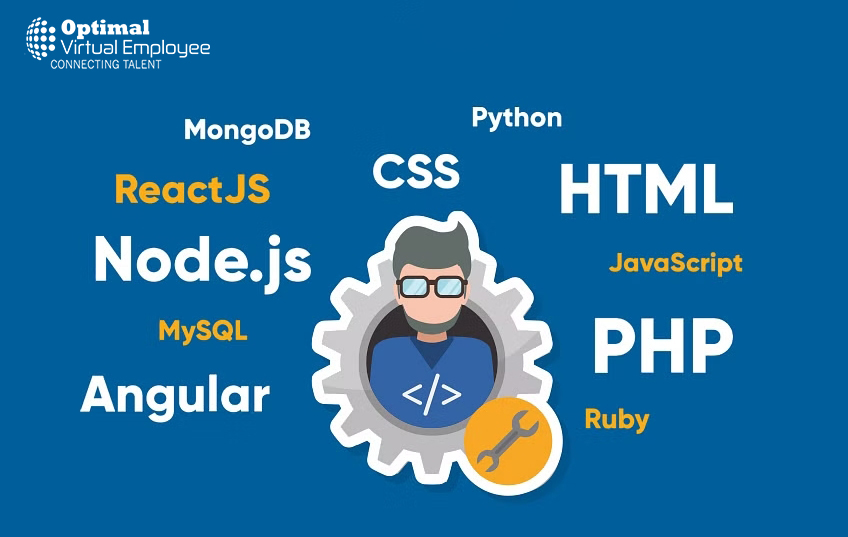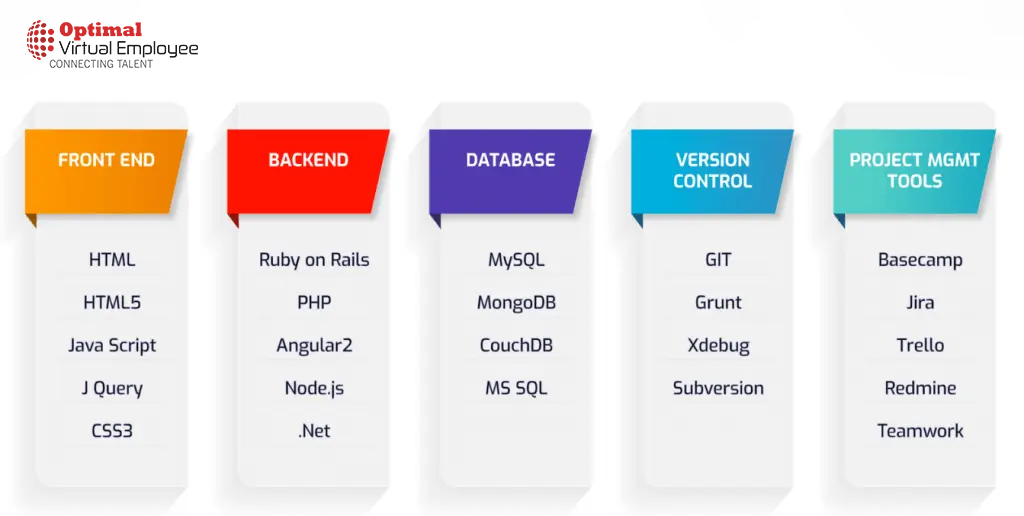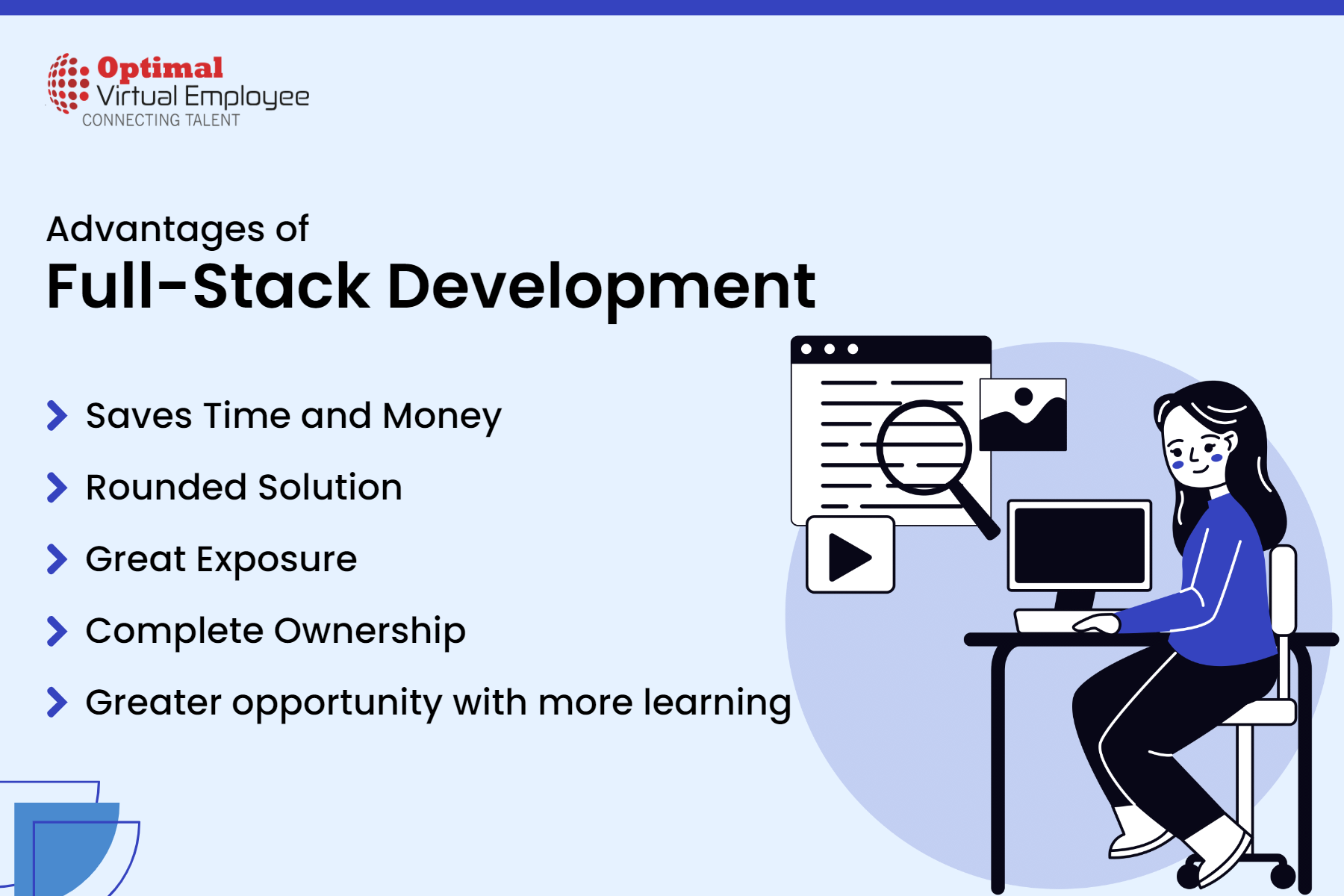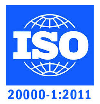Full-stack development has emerged as a popular trend among enterprises seeking to optimize development costs. However, it encompasses much more than just a cost-saving measure for web application creation.
In the realm of IT companies, full-stack web development has evolved into an increasingly sought-after skillset. From industry giants like Google to social media powerhouses such as Facebook, the demand for full-stack developers is rising.
But is all the excitement surrounding full-stack web development justified? Absolutely. According to a study by Codingdojo.com, the web development market is projected to experience a remarkable growth of 24% by 2025. Furthermore, these studies indicate that full-stack developers have consistently held one of the most coveted job positions over the past two years.
Moreover, full-stack solutions are not only cost-effective but also highly practical for most companies. With nearly 700 programming languages and an abundance of tools and frameworks available, focusing on mastering the positions of the essential and widely adopted one you as a full-stack developer. This strategic approach makes perfect sense, as it allows you to navigate the vast landscape of technology while delivering comprehensive solutions that encompass the entire development stack.
What is Full Stack Development?
If you still find yourself perplexed by the concept of full-stack development, allow me to provide a clear and concise answer.
Full stack development encompasses the comprehensive management of both the backend and frontend aspects of development by a single developer. These proficient individuals construct the frontend user interface and the backend engine that powers web applications.
The full-stack development team assumes the responsibility of ensuring an engaging front, a bug-free backend, and seamless integration and management of databases. They offer all-in-one development services, streamlining the entire process.
Key components of full-stack web development include:
– Programming the backend of applications
– Collaboration with a full-stack development team
– Building the front of applications
– Troubleshooting development issues
– Testing and launching the products
– Overseeing the web development lifecycle
– By embracing full-stack development, companies benefit from the expertise of versatile professionals who can handle multiple aspects of development, resulting in efficient and holistic solutions.
What Is a Full Stack Developer?
A full-stack web developer possesses the ability to develop both client-side and server-side software. They have a comprehensive understanding of HTML, CSS, and JavaScript, and may be proficient in frameworks such as jQuery, Angular, or Vue. Additionally, they are skilled in server-side programming using languages like PHP, ASP, Python, or Node.
What does “full-stack” mean? The term refers to a collection of tools, technologies, and programming languages necessary for the development and deployment of projects.
A full-stack developer possesses the versatility to independently complete a product. They can handle front-end UI programming, back-end development, databases, and servers. This expertise extends to native application stacks, mobile stacks, and web application stacks, showcasing their full-stack web developer skills. Consequently, instead of specializing solely as a front-end or back-end developer, acquiring the required full-stack developer skills empowers individuals to handle various aspects of app design, from start to finish. They become the Swiss Army knife of app development!
What Are the Skills Required for a Full-stack Developer?
Being a full-stack developer requires proficiency in various frameworks, programming languages, and databases. In the realm of front-end development, it is crucial to possess industry-ready expertise in HTML, CSS, JavaScript, jQuery, Angular, and ReactJS.
When it comes to back-end development, full-stack developers should excel in programming languages such as PHP, Java, Python, Node.js, and Ruby. It is particularly important to prioritize acquiring strong Java full-stack developer skills due to Java’s widespread popularity.
In terms of databases, full-stack developers must have a comprehensive understanding of MySQL, MongoDB, Oracle Database, and SQL Server. Additionally, practical knowledge of DevOps is crucial, including skills in CI/CD (Continuous Integration and Continuous Delivery) and related tools like GitLab and Jenkins.
To thrive as a full-stack developer, a solid collection of soft skills is also essential. These include excellent communication, efficient time management, curiosity, and creativity. If you intend to venture into mobile application development, skills in React Native are a must. Furthermore, for native app development, it is necessary to acquire proficiency in Kotlin and Swift.
What does a Full-stack Developer do?
In essence, a full-stack web developer is a versatile professional who excels in various areas of software development. They play a pivotal role throughout the entire development process, spanning from the backend to the front end.
When you engage a full-stack development company, you gain access to expert developers who possess comprehensive skills across all stages of software development.
Their primary responsibilities revolve around three key aspects:
Presentation Aspect
This entails designing and developing the front end, which encompasses the user interface of the web application. Expertise in HTML, CSS, and JavaScript is essential for creating visually appealing and interactive presentation layers.
Logical Aspect
The logical aspect involves the programming layer in full-stack software development. Here, full-stack developers write backend code using server-side programming languages such as Ruby and Python. They ensure the smooth functioning and logical implementation of the application.
Database Aspect
Working with relational and non-relational databases is an integral part of the full-stack developer’s role. They utilize technologies like PostgreSQL, MySQL, and others to handle database-related tasks. This involves storing data using tables or utilizing JSON formats.
In summary, full-stack web developers are akin to “jacks of all trades” in the development world. Their versatile skill set enables them to tackle diverse responsibilities, contributing to the success of software projects from end to end.
Benefits of Choosing Full-stack Developer
While the tasks involved in full-stack development may seem daunting, they present developers with numerous opportunities for growth, skill acquisition, and knowledge expansion. As the industry continues to evolve, staying updated with new technologies becomes essential, and amassing such knowledge offers several advantages. Let’s delve into the benefits of being a full-stack development professional.
High Demand:
Full-stack developers are in high demand due to their ability to work across all stages of the development process, including the display, logic, and database components. Employers value multi-skilled individuals who can adapt to market trends and handle diverse tasks. Entrusting a full-stack developer with a wide range of projects is possible because they possess expertise in all aspects of web development, ensuring efficient project management.
Creative Flexibility:
Full-stack developers possess comprehensive knowledge across various development domains, granting them greater flexibility in their work. With proficiency in both technical and creative aspects, they have more control over the products they build. Whether it involves PHP or CSS, full-stack developers understand both sides, allowing for enhanced creative freedom in their work.
Excellent Remuneration:
Full-stack developers in India earn an average of 6 LPA, with highly knowledgeable specialists reaching up to 14 LPA. Glassdoor reports the minimum salary for a full-stack developer in India to be around 3.5 LPA. Full-stack developers enjoy higher compensation due to their ability to save companies money on operational costs. Their versatility enables them to perform the work of multiple programmers, resulting in significant cost savings. Additionally, their skills in various frameworks and technologies contribute to their continuous high demand.
Increased Productivity:
One of the standout qualities of full-stack developers is their familiarity with multiple technologies. Whether it involves adding graphics to a web page or constructing a database, they are well-versed in these areas. This broad knowledge gives them an advantage in making technical decisions swiftly and seeing the bigger picture. Full-stack developers can make faster decisions and handle projects more efficiently, benefiting from quicker decision-making, creative freedom, and project control. This ultimately boosts their productivity and saves valuable time.
These are the notable advantages that full-stack development offers professionals in the job landscape. With its high demand, creative flexibility, excellent remuneration, and increased productivity, full-stack development presents a promising career path for those with the necessary skills and expertise.
What does becoming a Full-stack Developer involve?
A full-stack developer is an expert-level resource with a broad understanding of many development fields. This entails wearing a lot of hats and considering several factors.
Front-End Development:
Proficiency in fundamental front-end technologies such as JavaScript, HTML5, and CSS3 is a prerequisite. Additionally, familiarity with front-end JavaScript frameworks or third-party libraries like ReactJS, SASS, jQuery, and AngularJS is essential.
Back-End Programming:
Learning at least one server-side coding language is a necessity. Languages like Java, PHP, Ruby, and Python, among others, are well-suited for back-end programming. Having expertise in frameworks like .NET Framework can be advantageous in this domain.
Database Management:
A comprehensive understanding of database management systems is crucial for becoming a proficient full-stack developer. You should be familiar with systems such as MySQL, SQLite, Oracle, Microsoft Access, and others, in addition to programming languages.
Web Servers and APIs:
Familiarity with web servers and APIs is important. As a full-stack developer, you should continuously learn new skills to stay competent in your responsibilities. Having a foundational understanding of web architecture, including DNS, Cloud Storage, and Database Servers, is highly desirable.
Basic Design Fundamentals:
While development and design teams may differ, a versatile full-stack developer should have a fundamental understanding of design principles. This knowledge helps create engaging and interactive front-end experiences, as it aids in comprehending user psychology when working on the client side of the application.
Version Control Systems:
Proficiency in version control systems (VCS) such as Git and GitHub is essential for effectively managing codebases and making necessary modifications. Well-known Git repositories like GitHub, SourceForge, Azure DevOps Server, and Bitbucket are valuable tools for full-stack developers.
By acquiring these skills, you can embark on a successful full-stack development journey, empowering yourself to handle various aspects of web development with expertise and versatility.
Advantages of Full-stack Development
The Key advantages of Full Stack Development are:
– Saves Time and Money
– Rounded Solution
– Great Exposure
– Complete Ownership
– Greater opportunity with more learning
Cost and Time Efficiency:
With end-to-end visibility, full-stack developers possess a comprehensive understanding of how businesses should be created. Their ability to handle both frontend and backend tasks allows for seamless transitions, reducing development time and costs. Full-stack developers can efficiently tackle complex programming challenges, resulting in cost-effective solutions. Many companies now prefer hiring full-stack developers to meet project deadlines and budget constraints. This cost-effectiveness makes full-stack development particularly advantageous for small and mid-sized businesses, as it minimizes operational and contractual expenses.
Comprehensive and Efficient Solutions:
A developer well-versed in all tiers of development can create well-rounded solutions with fewer issues and improved efficiency. Testing and debugging become easier, leading to better overall outcomes and shorter development timeframes. Full-stack software developers consider the complete design structure, resulting in solutions that work seamlessly across the front end and back end. Their deep understanding of the program’s structure enhances the solution’s appearance and performance.
Ownership and Accountability:
Full-stack developers take complete ownership of their work, both frontend and backend. They handle the development process from start to finish and are solely responsible for resolving bugs and issues. This streamlined responsibility and accountability contribute to smoother development cycles and faster bug resolution.
Learning Opportunities:
Working on the full stack exposes developers to a wider range of technologies and skills. This opens up more learning opportunities and allows developers to broaden their expertise. Full-stack developers often adopt a solution-oriented mindset, enabling them to provide end-to-end product blueprints, both functionally and architecturally. Their continuous exposure to both frontend and backend domains provides ongoing learning possibilities, enabling them to continuously enhance and refine their skills throughout their careers.
In summary, full-stack development offers significant advantages, including cost and time efficiency, comprehensive solutions, ownership, and accountability, as well as increased learning opportunities. Embracing full-stack development empowers developers to deliver robust and holistic solutions, meeting the evolving needs of businesses.
Why Full-Stack Developers Are In Demand?
Organizations have compelling reasons to prefer hiring full-stack developers. Here are the key advantages they offer:
Expertise in Multiple Technologies:
Full-stack developers possess knowledge of various technologies, making them well-rounded professionals. In today’s rapidly changing technological landscape, where web and mobile app development requires proficiency in multiple languages, full-stack developers excel. Their expertise spans important aspects of software development, allowing them to navigate different technologies efficiently.
Cost-Effectiveness:
For startups and small enterprises, hiring a full-stack developer can be cost-effective. Full-stack developers possess a diverse skill set, capable of replacing multiple specialized roles within a team. This versatility saves costs and streamlines development processes. Even large enterprises are recognizing the value of full-stack developers due to their versatility, ability, and rich experience, leading to reduced development time and cost.
Flexibility and Time Efficiency:
Full-stack developers offer flexibility by working with a range of tools and frameworks for both backend and frontend development. This saves time and cost, particularly for startups and mid-sized businesses. Their ability to handle multiple aspects of the development process reduces the need for coordination between specialized roles, resulting in increased efficiency and faster time-to-market.
Versatility and Jack-of-All-Trades Approach:
The unique characteristic of full-stack developers is their versatility and ability to handle various tasks. While large organizations may prefer specialists in specific technologies, many tech giants are recognizing the value of full-stack developers. Their all-around expertise makes them valuable assets for companies seeking faster time-to-market and cost-efficient solutions. Their versatility also aligns well with the diverse tools and skills required in modern development practices, including database management, API development, coding in integrated environments, and an agile approach to development.
Career Perks:
The increasing demand for full-stack developers makes it one of the most sought-after professions among developers and students. Full-stack developers enjoy higher salaries, flexibility, future growth opportunities, and continuous learning. They can independently develop applications, reducing the need to hire multiple roles for development, and saving time and cost, particularly for startups and small-scale enterprises.
Overall, hiring full-stack developers brings numerous benefits, including their expertise in multiple technologies, cost-effectiveness, flexibility, time efficiency, versatility, and the perks associated with this in-demand profession.
Most Popular Tech Stacks Full Stack Developers Can Choose From:
Web and mobile app development employ a variety of tech stacks, which comprise frameworks, languages, platforms, and tools utilized in application building.
Some of the popular tech stacks for Full Stack development include:
LAMP Stack:
LAMP, short for Linux, Apache, MySQL, and PHP, is a classic tech stack widely employed in the creation of web applications. This open-source stack consists of an operating system (Linux), server (Apache), database (MySQL), and programming language (PHP). While Linux is commonly used as the operating system, developers may also opt for WAMP (Windows as the OS) or MAMP (MAC OS) to develop dynamic and stable web applications.
MEAN Stack:
MEAN represents MongoDB, Express.js, Angular, and Node.js. This stack holds significant dominance in the realm of full-stack development as it is entirely JavaScript-based. Each framework within this stack boasts immense popularity and benefits from extensive support from a vibrant and sizable community. Leveraging JavaScript for server-side scripting through Node.js, this tech stack has brought about revolutionary advancements in web development. It is widely adopted for constructing scalable, robust, and visually appealing applications.
MERN Stack:
Similar to MEAN Stack, MERN Stack replaces Angular with React. React is a JavaScript library utilized for constructing interactive user interfaces and single-page applications. It is actively maintained by Facebook and a thriving community, making it one of the most popular front-end libraries.
Ruby on Rails:
Ruby on Rails is a classic and widely adopted tech stack for end-to-end application development. RoR developers possess expertise in working on the front, backend, and database components. Ruby, an open-source programming language, is combined with Rails, a server-side web application framework, to form this stack.
Python Full Stack:
Python full-stack web developers are in high demand due to Python’s widespread usage and modern nature. Python is a versatile programming language used to build fast and scalable web applications. It is particularly suitable for machine learning and data science applications, thanks to its simple syntax and powerful features. Django, a popular Python-based framework, is an integral part of the full stack Python stack, which also includes Python, Django, Apache, and MySQL.
Java Stack:
Java Stack involves utilizing the Java suite of technologies to develop web applications. It encompasses core Java, servlets, REST APIs, JSP, Hibernate, Spring, and other common web technologies like CSS, JS, and HTML. Java has been a prominent programming language for over two decades, contributing to the enduring popularity of this stack. Java’s versatility makes it suitable for a wide range of applications and use cases.
We have previously covered the essential skills required to become a full-stack developer. Now, let’s delve into the roles and responsibilities that come with being a full-stack developer.
Conclusion: Full Stack Software Development is the Future
Full-stack development addresses several critical challenges in web development, such as inefficiency, ineffective communication, development issues, delivery backlogs, and more. By encompassing the entire software development process, it offers solutions to these problems.
Efficiency and cost play a pivotal role in web development, and this is why enterprises are increasingly inclined to hire full-stack developers. It’s a logical choice as organizations strive to save resources while attaining top-notch products. Full-stack software development provides the means to achieve these goals effectively.













